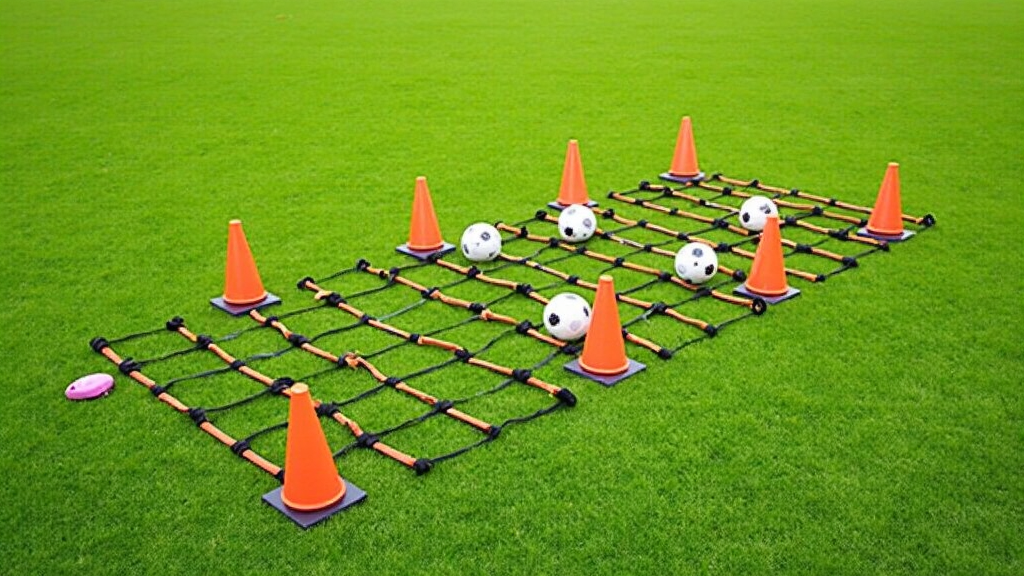Speed And Agility Soccer Drills
If you’re aiming to get faster and more agile on the soccer pitch, nothing gets you there quite like focused speed and agility drills. Whether you’re building up your own skills or coaching a group, knowing what drills make a difference is really important. I put together a collection of my go-to drills and favorite training tips for anyone who wants to work on their quickness, reactions, and movement in soccer.

Why Speed and Agility Matter in Soccer
Speed and agility aren’t just for track stars. In soccer, a mix of quick footwork, explosive sprints, and rapid changes in direction decides who gets to the ball first and who stays two steps ahead of the opponent. Fast breaks, defensive recovery, changing pace to lose defenders, and even basic ball movement all come down to sharpness on your feet.
Soccer is played at such a high tempo these days that trainers and players put a huge focus on improving plyometrics, sprinting form, foot speed, and reaction time. These skills get the biggest boost from a smart combination of speed and agility drills. Investing time into this part of your training routine can take your play up a notch, no matter your position. Quick footwork and strong coordination help you not only with attacking but also while tracking back defensively, making speed and agility essential for everyone on the field.
Foundational Soccer Speed and Agility Drills
When you’re building your speed and agility routine, it’s smart to start with fundamental drills that target acceleration, lateral quickness, and body control. These drills form the base for advanced moves and game situations, and they’re also simple to set up with basic home or field equipment.
- Agility Ladder Work: Grab an agility ladder and practice drills like singleleg hops, lateral shuffles, and quick forward steps. Agility ladders teach you to pick up your feet quickly and stay light on your toes, which is perfect for sudden changes in direction during games.
- Cone Sprints: Set up 5–8 small cones in a zigzag or T pattern. Sprint, shuffle, and backpedal between cones to simulate real movement during matches. Working with cones helps with foot placement and makes you more comfortable moving in every direction.
- 5105 Shuttle Run: Set three markers five yards apart in a straight line. Sprint to the first marker, backpedal to the starting point, and then sprint to the farthest marker and back. This drill boosts acceleration and deceleration, which are really important for defensive recovery and bursting past defenders.
Running these drills regularly lays a solid foundation, especially for new players or those coming back from a break. It’s also a good idea to record your times or have someone else watch your form so you can check out your technique over time.
How to Use Agility Ladders for Soccer Training
Agility ladders are a favorite tool of mine for one simple reason: they encourage quick, technical footwork without much setup. You don’t need much space, and they offer a ton of variety, so you won’t get bored. Focusing on agility ladders also helps with body coordination and rhythm, which are vital skills for keeping control in high-speed situations.
- In-and-Out: Start at one end of the ladder. Step both feet in and out of each rung, moving sidetoside. Go for speed, but focus on not clipping the ladder.
- Lateral Shuffle: Face sideways and move along the ladder, shuffling your feet in and out with each step. Try to keep your hips low and stay balanced for better control.
- OneFoot Hops: Hop on one foot from one end of the ladder to the other, switching feet each round. It’s a simple drill, but it wakes up your ankles and improves overall balance.
After your ladder routine, you’ll probably notice that your feet feel lighter and your responses a bit quicker during games. That’s when you know this training is paying off. If possible, use video to check out your movement and make little tweaks for faster improvement.
Quick Progress: SprintFocused Soccer Drills
Soccer sprints aren’t just about running straight. Players need to react, start, and stop quickly, and cover short distances with maximum power. Here are a few sprintfocused drills I recommend for maximum field impact:
- Short Distance Sprints: Mark out 10–20 meter distances. Work on your sprint starts, focusing on being explosive off the line. Walk back for recovery, and repeat several times. Try timing your sprints to track progress.
- Reaction Sprints: Have a partner call out “go,” flash a color, or toss a ball to signal when you should explode into your sprint. This adds a reaction element similar to what you’ll face on the field, so you develop that extra edge on game day.
- Sprint and Backpedal: Sprint forward 10 meters, then immediately backpedal to your starting mark. This trick works your muscle memory in a good way and adds a gamerealistic element where you shift from attack to defense.
Gradually add extra sprints or tweak distances as your fitness improves. Sprints are tough, but they bring real results and power up your ability to break away or recover during matches. If you are working in a group, try sprint relays to add some fun competition and extra motivation.
Mixing in Ball Control With Agility
Speed and agility matter more when you can maintain control of the ball. I like weaving in touches, dribbles, and short passes to keep drills relevant. Here’s how you can make agility training more soccer-specific:
- Ladder With Ball Dribbling: Run basic ladder drills, but dribble a ball through at your side. Start slow, then work on keeping close ball control at higher speeds. Add turns at the end of the ladder for extra challenge.
- Cone Weave Dribble: Dribble in and out of a line of cones at full speed, pivoting at each end. Try using both feet, experimenting with tight versus wide turns, or add a passing partner for pressure.
- OneTouch Passing After Sprints: Sprint to a marker and receive a sharp onetouch pass from a teammate or rebounder. This is awesome for combining first touch and recovery after fast movement, and helps create composure under pressure.
These ballcentered agility drills turn raw movement into gameready skills, boosting not only your speed but also your ball technique under pressure. If you’re training solo, bounce passes off a wall for similar benefits.
What To Watch Out For With Speed and Agility Training
Getting faster and more agile isn’t only about working as hard as possible. Here are a few common snags I’ve seen players run into, with tips on how to sidestep them:
- Poor Technique: If you’re not focused on quick, controlled movement, bad habits can creep in. Take it slow at first until you get the drill down, then speed up. Always start with good, strong posture and land softly when jumping or bounding.
- Not Enough Recovery: Sprint and agility work is tough. Build in enough rest to keep your form sharp and avoid burnout. Add gentle stretching between drills for extra muscle care.
- No Progression: If you stick to the same drills forever, your gains will level off. Switch up drills, distances, or add new challenges every few weeks to keep things fresh. Trying new setups, using more complicated patterns, or adding resistance bands can push your progress forward.
Listening to your body and mixing up your routine keeps things safe and productive, and it helps make every training session count. Adding a logbook or app to note progress can keep you motivated for the long haul.
ProLevel Drills for Soccer Agility and Speed
Ready to challenge yourself or your squad? These advanced drills are popular among both youth and adult players aiming to really give their game-day agility a boost:
Mirror Sprints: Pair up with a teammate. One player leads, changing directions and speeds along a line, while the other mirrors every move as quickly as possible. This drill sharpens lateral movement and reaction time, just like tracking an opponent. Over time, switch leaders to keep both players on their toes.
Hexagon Drill: Mark a hexagon shape on the ground. Start in the center and explode out to each cone in sequence, then return to the middle. Keep things quick, and try to stay low for balance. This drill brings in sharp directional changes you’ll see in high-level play and really works your legs and concentration.
Lateral Bounds With Ball Recovery: Bound laterally side to side over a small barrier. After five bounds, chase after a loose ball rolled away by a coach or teammate. This ties together power, balance, and gamelike ball pursuit.
Stepping up to these prostyle drills can push serious improvements in match speed and confidence, especially for competitive players. Building these into your warmup or main workout block twice a week can make a big difference when the stakes are high.
Practical Tips for Getting the Most Out of Agility Sessions
Having the right equipment makes a big difference in how effective and fun your training sessions are. Here’s what I always bring to the field for speed and agility work:
- Agility ladders for quick feet and coordination. Simply roll it out, and you’ve got a full session ready.
- Cones or small discs for setting up sprint, weave, or shuttle patterns. They’re light and pack down small. You can even use extra shoes or water bottles as standins.
- Stopwatch or timing app, because tracking your times makes progress easier to see. Many phones have simple apps that help you set work and rest intervals.
- Soccer balls for mixing in ball control challenges right away. Use them in most agility drills to make everything more soccerrelevant.
Also, make sure to start every session with a thorough warmup like dynamic stretches, a light jog, and some mobility movements to lower your chances of injury and shake off any stiffness before you start pushing your speed. Cooling down after intense drills with a walk and stretch also lowers soreness and helps your body recover more effectively.
If you’re training younger kids or a group of new players, turn drills into games or relay races. This will keep things lively and make everyone want to get involved more often, speeding up learning and making training something to look forward to.
Frequently Asked Questions
Here are a few common questions I get about soccer speed and agility drills:
Question: How often should I train speed and agility for soccer?
Answer: Twice per week is a good place to start for most players. If you train hard or play multiple matches each week, keep the sessions short and focused to avoid overtraining.
Question: What age should players start agility ladder drills?
Answer: Youth players as young as 7 or 8 can start using ladders. Start with easy drills, and focus on making it fun rather than perfect technique at first. Play music or use upbeat routines to keep young players interested.
Question: Can speed and agility drills prevent injuries?
Answer: They can help, since improved balance, control, and muscle strength mean you’ll react better to unexpected movements or collisions. Always combine drills with stretching and strength exercises for the best benefits.
Final Thoughts
Speed and agility are two of the biggest assets a soccer player can build, and these drills are a straightforward way to make real gains. Incorporating ladders, sprints, and cone patterns keeps training sessions interesting and matches feeling a lot easier. When you combine these drills with ball control, you’re training for the way the sport is actually played. Sticking with it and tweaking your routines as you improve will help you stay quick and competitive on the pitch. Remember, fun and consistency go hand in hand, so keep at it, push yourself, and track down those extra steps for peak performance every time you play.
